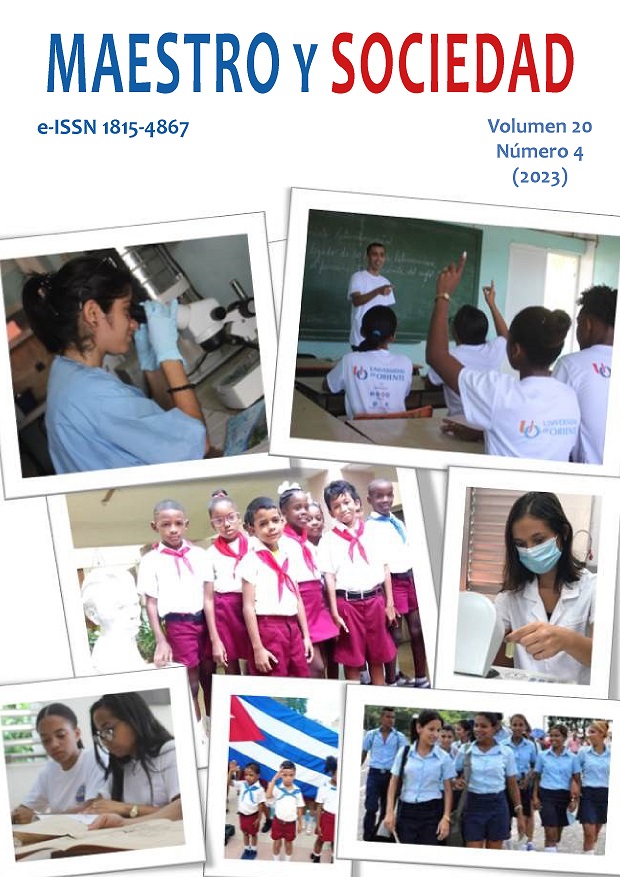Influence of the use of TIC on the interpersonal relationships of a 12-year-old child
Keywords:
Children, Tics, interpersonal relationshipsAbstract
Introduction: Several studies have been carried out for some time that indicated that the excessive use of technological
devices can have negative effects on the social and emotional development of children. Objective: The article deals with
the impact that information and communication technologies have on the interpersonal relationships of a 12-year-old
boy. Methods: The study was carried out through qualitative research and with the case study method, observation and
the application of interviews with a child of this age and his mother were used, and the influence of tics on interpersonal
relationships was verified. Results and discussion: Its inappropriate use has been shown to affect the way you interact
with your family and friends, it can also decrease your ability to communicate and prevent you from resolving conflicts
effectively. However, it has been found that the proper use of technology benefits relationships in social networks and
online games by providing a space for friendship building and team collaboration. In addition, the technology helped the
child to expand her social circle and connect with people from all over the world. Conclusions: the research highlights
the convenience of a balanced and conscious use of technology supervised by the family, to vivify positive interpersonal
relationships in 12-year-old children. It is necessary to promote a digital education that teaches to develop personal
relationships using virtual human contact in a responsible manner without forgetting the necessary face-to-face space.
References
Alfaro, M., Váquez, M., Fierro, A., Herrero, B., Muñoz, M., & Rodriguez, L. (2015). ). Uso y riesgos de las tecnologías de la información y comunicación en adolescentes de 13-18 años. Acta Pediátrica Española, 73(6), e126-e135.
Alvarez Cadena, K. A., Pilamunga Asacata, D. E., Mora Alvarado, K. G., & Narajo Kean Chong, M. K. (2020). Tiempo en pantalla (televisión, computadora, celular, tabletas) en las relaciones interpersonales entre niños de 8 a 12 años. Horizontes: Revista de Investigación en Ciencias de la Educación, 4(15), 258-266.
Aristizábal García, D. M. (2020). Niños “conectados”: una aproximación etnográfica a las experiencias de niños, familias y escuela a partir del uso de tablets. RUNA, Archivo para las ciencias del hombre (Instituto de Ciencias Antropológicas, Facultad de Filosofía y Letras, Universidad de Buenos Aires), 41(2), 257-278. https://doi.org/10.34096/runa.v41i2.6184
Berríos, L., Buxarrais, M.-R., & Garcés, M.-S. (2015). Uso de las TIC y mediación parental percibida por niños de Chile. Comunicar, 161-168.
Bringué Sala , X., Sádaba Chalezquer, C., & Artopoulos, A. (2014). La generación interactiva en Argentina: niños y adolescentes ante las pantallas . Revista de Política Educativa , 1-23.
Chevalier Naranjo, S. (8 de febrero de 2021). ¿Qué riesgo corren los niños al conectarse a internet? https://es.statista.com/grafico/24110/los-ninos-y-la-seguridad-en-linea/
Cloquell Lozano, A. (2015). Usos sociales de internet entre los adolescentes españoles. Revista Sobre La Infancia Y La Adolescencia, 8, 1-14. doi:https://doi.org/10.4995/reinad.2015.3649
Gewerc, A., Fraga, F., & Rodés, V. (2017). Niños y adolescentes frente a la Competencia Digital. Entre el teléfono móvil, youtubers y videojuegos. Revista Interuniversitaria de Formación del Profesoral, 89(31.2), 171-186.
Gómez Cano, C. A., Sánchez Castillo, V., & Santana González, Y. (2023). Factores que inciden en la procrastinación académica de los estudiantes de educación superior en Colombia. Universidad y Sociedad, 15(4), 421-431. https://rus.ucf.edu.cu/index.php/rus/article/view/3995
Hormaechea Lastra, E. (2018). La adicción a las TICs e Internet en adolescentes. Cantabria: Repositorio institucional de la Universidad de Cantabria.
Instituto Nacional de Estadística, Geografía e Informática (INEGI). (14 de mayo de 2020). https://www.inegi.org.mx/contenidos/saladeprensa/aproposito/2020/eap_internet20.pdf
Iño Daza, W. G. (2018). Investigación educativa desde un enfoque cualitativo: la historia oral como método. Voces De La Educación, 3(6), 96. https://www.revista.vocesdelaeducacion.com.mx/index.php/voces/article/view/123/110
Lugo Rangel, A. (11 de 2019). El rendimiento académico y el sueño en la Educación Media Superior: el caso de un bachillerato en Ciudad Juárez. Juárez: http://erecursos.uacj.mx. Recuperado el 10 de junio de 2023, de http://erecursos.uacj.mx/bitstream/handle/20.500.11961/5528/TESIS%20FINAL-2019-ALR-171403.pdf?sequence=1&isAllowed=y
Mamani Escalante, K., & Choque Mamani, J. P. (2019). Uso de las TICs y sus efectos en las relaciones interpersonales
de los estudiantes de la Escuela Profesional de Sociología de la UNA - Puno 2016. Puno: Universidad Nacional del Altiplano (Perú). Obtenido de https://repositorioslatinoamericanos.uchile.cl/handle/2250/3278895
Martinez Dominguez, M. (2018). Acceso y uso de tecnologías de la información y comunicación en México: factores determinantes. PAAKAT: rev. tecnol. soc. [online], 8(14), 1-21. https://doi.org/10.32870/pk.a8n14.316
Vuanello, G. R. (2015). Los niños frente a Internet: seguridad, educación y tecnología. Trayectorias, 107-129.
Published
How to Cite
Issue
Section
License
Copyright (c) 2023 María del Carmen Santos Fabelo, Carlos Gaddiel Guerrero Plantillas

This work is licensed under a Creative Commons Attribution-NonCommercial-NoDerivatives 4.0 International License.
This journal provides immediate open access to its content, based on the principle that offering the public free access to research helps a greater global exchange of knowledge. Each author is responsible for the content of each of their articles.



























 Universidad de Oriente
Universidad de Oriente 